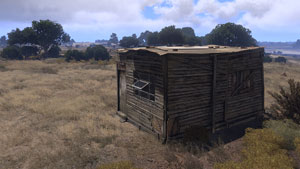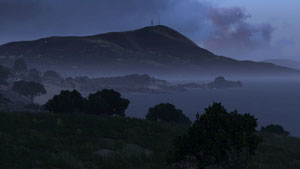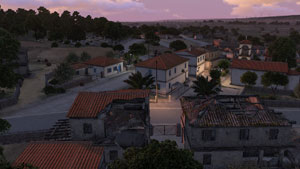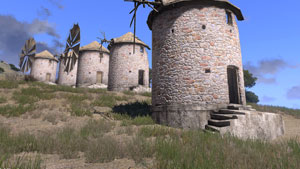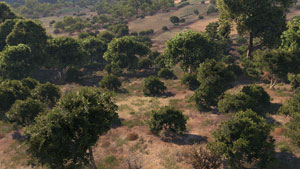While the development team is hard at work to deliver the first Arma 3 campaign episode, the game’s massive islands have already been deployed. Considered as the crown jewel of Arma 3 by many virtual combatants, we talked to one of Altis’ masterminds, Environment Lead Martin Pezlar!
We're often asked to let some of our people talk about what it's like to develop a game at BI. 'Report In!' gives you a more personal perspective on our team, a more detailed look at the way we go about our work, and fresh information about our ongoing projects.
In his role as Environment Lead, Martin is responsible for the massive terrain in Arma 3. His team’s ambition resulted in a landscape of over 290 km2 - surpassing all previous BI games (comparison image). However, not only scope, but also level of detail and lighting were pushed to the next level. Mix in a bizarre adventure in Greece, and we have more than enough ingredients for a Report In™ dev interview!
Introduction
Tell the people a little about yourself. What's your role? How long have you been with Bohemia Interactive? Which projects have you contributed to and what is your favourite BI game or mission?
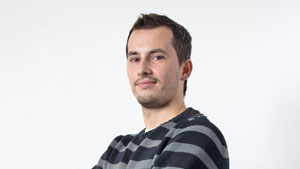 Greetings! My name is Martin Pezlar, perhaps better known by my nickname ‘Maxell’ on the Internets. I’ve been working as a Lead Environment Artist for 2 years now. Before that, I worked at BI as a regular Environment Artist, also for about 2 years. I was recruited back in 2010 from the ranks of the Quake 3/Doom 3 map design community. My first task at BI was to develop Takistan for Arma 2: Operation Arrowhead. I then later worked on the smaller Shapur map (Arma 2: British Armed Forces) and Proving Grounds (Arma 2: Private Military Company). Naturally, my favourite BI game is the latest, most polished, and most beautiful instalment in the Armaverse: Arma 3.
Greetings! My name is Martin Pezlar, perhaps better known by my nickname ‘Maxell’ on the Internets. I’ve been working as a Lead Environment Artist for 2 years now. Before that, I worked at BI as a regular Environment Artist, also for about 2 years. I was recruited back in 2010 from the ranks of the Quake 3/Doom 3 map design community. My first task at BI was to develop Takistan for Arma 2: Operation Arrowhead. I then later worked on the smaller Shapur map (Arma 2: British Armed Forces) and Proving Grounds (Arma 2: Private Military Company). Naturally, my favourite BI game is the latest, most polished, and most beautiful instalment in the Armaverse: Arma 3.
And can you give us some random facts about yourself?
I love life, surprises, fast motorcycles, perfection and efficiency, intelligent humor and having the sun shine on my back. I hate laziness, human stupidity, and arrogance.
The Promised Land

Can you start by explaining a little bit about the terrain development process?
Phew! Where to start! The terrain development process is kind of a marathon – it’s a massive task. Let me try to capture the most essential stages.
First of all, you have to have a clear goal: what kind of map do you want to create, what should it look like, what features should be present. This means you always need to do some rock solid research. All of this drives the initial analysis and design, which is then evaluated by all of the Department Leads, the Creative Director and the Project Lead.
Once everyone and everything is aligned, we move on to build a very basic map prototype. This is just a quick, low-quality terrain mesh with low resolution textures and simple mockup buildings. It helps to test the in-game scales, proportion and overall feel. Once everyone is happy with the prototype, we move ahead and start preparing a list of all the assets required for the final production version of the map. This again involves a lot of analysis and spreadsheets, which ultimately serve as the battle plan for the Art and Environment Departments.
Finally, when these documents have been approved and finished, the real, high quality, production of the required assets can begin. Simultaneously, the creation of the landscape itself, the map layout, the sculpting of the terrain, and the satellite textures is starting. Then, *crash-boom-bang*, 2.5 years later, we have a brand new game world.
So most, if not all, disciplines and departments are involved?
 Definitely - from the tiny ambient butterflies to particles, sounds, interactions, collisions, lighting and AI. The game world interconnects all features, thus the input of all departments is required. The artists, for example, work on models, such as vehicles, trees and buildings. Then, all those models have to be configured properly by the Encoding Department. Obviously, the engine also needs to support the features of each model. That would be the duty of our almighty Programming Department. These are just some examples, but as you can see, everything is connected to everything. In order to deliver the illusion of a living world, everything has to work precisely and robustly, and come together to form one great symphony.
Definitely - from the tiny ambient butterflies to particles, sounds, interactions, collisions, lighting and AI. The game world interconnects all features, thus the input of all departments is required. The artists, for example, work on models, such as vehicles, trees and buildings. Then, all those models have to be configured properly by the Encoding Department. Obviously, the engine also needs to support the features of each model. That would be the duty of our almighty Programming Department. These are just some examples, but as you can see, everything is connected to everything. In order to deliver the illusion of a living world, everything has to work precisely and robustly, and come together to form one great symphony.
How long does it take to create the first prototype?
Making the first map prototype is a fairly quick and easy task. As I mentioned before, you start with a very low quality map for testing purposes. We’re not building the entire map at this stage - just two or three towns, perhaps some important areas, so we can test whether it works or not. But to give a direct answer to the question, depending on the actual size of the planned map, the prototype can be pulled off within a month.
What would you say are the most significant challenges in designing a terrain?
For starters, I wouldn’t look so much for the most ‘significant cases’. There are plenty of ordinary, small challenges during development, and it’s the total amount that can sometimes make it a horror. Even if you think that issues are insignificant and harmless, they can and probably will join forces later on and come back at you big time. Not to mention the complications that seemingly appear out of nowhere.
 But to be more concrete, there’s an eternal battle between what looks good and what actually works in the engine. We constantly have to look for the best compromise between appearance/functionality/performance. We could certainly build a map even more beautiful than Altis, but it would be unusable for the AI or it would run terribly on most computers. The search for that fragile balance is sometimes very hard and painful.
But to be more concrete, there’s an eternal battle between what looks good and what actually works in the engine. We constantly have to look for the best compromise between appearance/functionality/performance. We could certainly build a map even more beautiful than Altis, but it would be unusable for the AI or it would run terribly on most computers. The search for that fragile balance is sometimes very hard and painful.
Another challenge is the vastness and detail of the world. Altis is not just an island, in computer game scales, it is a huge continent: a continuous large-scale map, and the largest terrain made in the Arma series yet. To give you an idea, the Altis map contains more than 1.7 million manually placed models and more than 16 million carefully sculpted terrain vertices – all placed by our five-member environment team.
So, as you can probably imagine, this job requires a lot of patience and endurance. That is also why we often joke that we’re not really artists, but laborers – a ‘vertices-pulling-and-models-pushing’ bunch of monkeys. Funnily enough, or sadly (just kidding), that is also largely true - or at least it’s what we’re doing most of the time ;)
The Island of Opportunity

Much of the vision for Arma 3 relates back to authenticity, diversity and opportunity. These key words seem directly applicable to the environment. Could you elaborate how these keywords relate to Arma 3’s environment?
Let’s start with perhaps the most obvious one: authenticity. We always aim to make our environment look like it could be a possible location on Earth. This means that all the vegetation, rock formations, building architecture, and even animals, are consistent, believable and based on real-world sources. Moreover, we use real satellite imagery and height maps as initial data to ensure the highest possible map authenticity. To give you a complete random example of our map authenticity: you can use the traffic signs and signposts on Altis to drive and navigate - just like in the real-world.
 Moving on to diversity, here we’re talking for instance about the different types of locations: villages, larger towns, industry compounds, airstrips, forests, mountains, beaches, etcetera. We try to offer many various types of locations to facilitate the creation of diverse and unique missions.
Moving on to diversity, here we’re talking for instance about the different types of locations: villages, larger towns, industry compounds, airstrips, forests, mountains, beaches, etcetera. We try to offer many various types of locations to facilitate the creation of diverse and unique missions.
Related to this, if you look at opportunity, I would say that this might even be the most important aspect for players. The map is made with mission-makers in mind, which means it is a sandbox with a lot of areas for you to build your own mission structures. There should be enough ‘coincidentally’ convenient empty spaces to do so. This, multiplied by the sheer size of Altis, results in so many creative possibilities and tactical options for creating any kind of scenario.
Out of passion, you decided to visit Lemnos – the island which served as a main source of inspiration – for holidays. However, a couple of days into your vacation, you suddenly found yourself in the most bizarre of circumstances. Can you shortly describe what it was like, how it was to come back, and how you felt about rejoining the development team?
Since this case is still active, I cannot go into too much detail, but yes, it was a terribly surreal experience. Try to imagine that you’ve packed luggage for a ten day vacation, bringing your flip-flops and swimsuit, all to suddenly end up spending a winter in a cold old prison with a 20 year prison sentence hanging above your head. It was not the kind of all-inclusive vacation you’d want. Despite all of that, we still were a bit lucky as Ivan and I weren’t separated. Everything is much better when you have a friend to stay with you.
 Nevertheless, after 129 days in prison, my hope for a return had gotten very low. Thus, when I heard that we would be released on bail, I naturally didn’t believe it. I will never forget that indescribable feeling: the flood of all senses when I walked through the prison gate and was once again free. After we had finally returned back to our country, I was so happy to be with my girlfriend, with my family and friends again. Not only because of myself, but even more so because I knew they would no longer need to worry about me.
Nevertheless, after 129 days in prison, my hope for a return had gotten very low. Thus, when I heard that we would be released on bail, I naturally didn’t believe it. I will never forget that indescribable feeling: the flood of all senses when I walked through the prison gate and was once again free. After we had finally returned back to our country, I was so happy to be with my girlfriend, with my family and friends again. Not only because of myself, but even more so because I knew they would no longer need to worry about me.
A few days later, I also rejoined our development team. They welcomed both me and Ivan with open arms and everyone was incredibly happy to have us back safe and sound. However, even so, in the beginning I was afraid that our holiday adventure had left such a bad taste in my mouth that I wouldn’t want to work on the Altis map anymore. Fortunately, I overcame this fear quite fast and I was able to catch up with all the new things that had happened in the project and the team during my absence. Seeing the excitement within the team and from our Alpha participants became the perfect fuel for igniting my passion again.
Kingdome Come

Very happy to hear! Let’s move to a lighter topic. Could you give us a hint for finding an Easter egg on Altis?
The idea behind Easter eggs is that you need to hunt for them. I don’t want to spoil all the fun by revealing even a single one. Please don’t hate me for it; the greater your motivation, the greater the reward when you succeed. Believe me, Altis is full of them. Just keep your eyes peeled during your exploration.
Roger that! So how has the reception of Arma 3, in particular Altis, been for you?
It has been a very thrilling and exciting time. All members of the Environment Department have been very excited about working on such a humongous map and couldn’t wait to see the reactions of players. When we saw that most reactions were positive and sometimes nearly ecstatic, it was a huge relief and satisfaction for all of us.
Are you happy with the result?
Yes I am, or sort of. Given the timeframe, manpower, tools and resources, I think we exceeded a lot of expectations. But, with better technology and tools, I think we can do even better – so I look forward to future projects.
The upcoming campaign is set on Altis and Stratis. Is there still work left for the Environment Department?
Not really, the main features of both maps were already finished with the campaign in mind. The campaign-related tasks for maps we have now are just some small adjustments here and there for existing locations.
So what’s next?
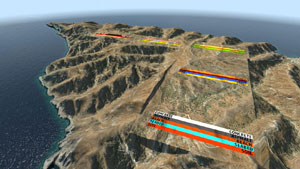 At the moment we’re still working on a new batch of improvements for the Altis map. This includes new detailed models, such as phone booths, benches, kiosks, etcetera, and even new locations, such as a ruined Ghost Hotel compound and the Stadium. These should be made available (for free) in the near future. For the rest, we’re also now starting to make plans for DLCs. But, whatever it will be, I’m sure that there will be new detailed models and even new locations. Just wait for the surprise!
At the moment we’re still working on a new batch of improvements for the Altis map. This includes new detailed models, such as phone booths, benches, kiosks, etcetera, and even new locations, such as a ruined Ghost Hotel compound and the Stadium. These should be made available (for free) in the near future. For the rest, we’re also now starting to make plans for DLCs. But, whatever it will be, I’m sure that there will be new detailed models and even new locations. Just wait for the surprise!
General Questions

And after a long day of making games, what do you like to do to relax and unwind?
There are many things I do to clear my thoughts, but riding a motorcycle on the road or on the nearby Brno Circuit is probably my favorite pastime.
What tips would you give to aspiring map designers?
Always be on the lookout for inspiration, nature itself – wherever you are - is the ultimate masterpiece. You can start by trying to make a virtual copy – even though your first will probably be a lousy one. Then work, and work harder again, to make your copies better!
Spreading into virtual ecosystems, global warming causes natural disasters in all of the world’s video games. As temperatures continue to rise, you launch a counter-movement to save your favorite game from a cyber-meltdown. Planting trees, recycling waste, changing light bulbs, and cycling as you go - which game would it be?
As I already hinted earlier, it would be Quake 3 Arena and its editing tools ;)
